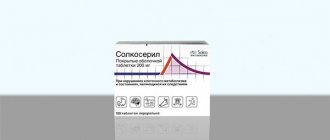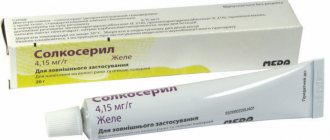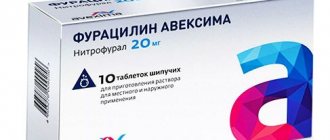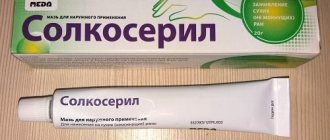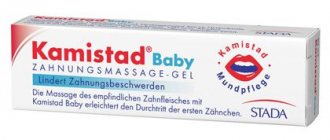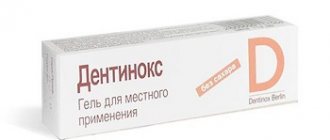What is Solcoseryl ointment used for?
The drug is based on deproteinized dialysate obtained through special processing from the blood of calves. This substance is often used in medicine in countries such as China, Korea, and the entire CIS. It has proven itself to be an effective remedy that can:
- enrich tissue cells damaged due to hypoxia with oxygen and glucose;
- start tissue repair processes;
- activate healthy cell division processes;
- increases the level of energy produced by cells;
- protects the skin from external damage by forming a film on its surface;
- triggers the production of collagen by tissues.
Based on the activity of the drug, the drug can be used for:
- frostbite;
- psoriasis;
- anal ring cracks;
- cuts;
- abrasions;
- scratches;
- bedsores;
- acne marks;
- dermatitis;
First of all, to achieve the best effect, it is necessary to start therapy in the early stages of the problem.
Solcoseryl gel for external use 10% 20g
Compound
Active substance: deproteinized dialysate from the blood of healthy dairy calves (in terms of dry matter) - 4.15 mg. Excipients: methyl parahydroxybenzoate, propyl parahydroxybenzoate, sodium carmellose, propylene glycol, calcium lactate pentahydrate, water supplement.
Indications for use
- minor damage (abrasions, scratches, cuts);
- 1st and 2nd degree burns (sunburn, thermal burns);
- frostbite - difficult-to-heal wounds (including trophic ulcers and bedsores).
For the treatment of trophic lesions of tissues of various origins, Solcoseryl is used only after removal of necrotic tissue from the wound.
Solcoseryl gel is used in the initial stage of treatment and is applied to fresh wounds, wounds with wet discharge or ulcers with weeping phenomena.
Contraindications
Hypersensitivity to one of the components of the drug.
Use with caution if you are predisposed to allergic reactions.
Directions for use and doses
Solcoseryl is used topically, applied directly to the wound surface after preliminary cleansing of the wound using a disinfectant solution.
Before starting treatment of trophic ulcers, as well as in cases of purulent infection of the wound, preliminary surgical treatment is necessary.
Solcoseryl gel is applied to fresh wounds, wounds with wet discharge, and ulcers with signs of weeping in a thin layer on a cleaned wound 2-3 times a day. It is recommended to lubricate areas where epithelization has begun with Solcoseryl ointment. The use of Solcoseryl gel is continued until pronounced granulation tissue forms on the damaged skin surface and the wound dries out.
For the treatment of severe trophic damage to the skin and soft tissues, the simultaneous use of parenteral forms of Solcoseryl is recommended.
Storage conditions
Store out of the reach of children at a temperature not exceeding 30°C.
Best before date
5 years. Do not use after the expiration date stated on the package.
special instructions
Solcoseryl should not be applied to a contaminated wound, since it does not contain antimicrobial components.
If you experience pain, redness of the skin near the site where Solcoseryl was applied, secretion from the wound, or increased temperature, you should immediately consult a doctor.
If, when using Solcoseryl, healing of the affected area is not observed within 2-3 weeks, you should consult a doctor.
Description
A drug that improves trophism and tissue regeneration, for external use.
Dosage form
The gel for external use is homogeneous, almost colorless, transparent, dense in consistency, with a characteristic slight odor of meat broth.
Pharmacodynamics
Solcoseryl is a deproteinized hemodialysate containing a wide range of low molecular weight components of cell mass and blood serum of dairy calves with a molecular weight of 5000 D (glycoproteins, nucleosides and nucleotides, oligopeptides, amino acids).
It has been established that Solcoseryl has the following properties:
- improves the transport of oxygen and glucose to cells under hypoxic conditions;
- increases the synthesis of intracellular ATP and promotes an increase in the proportion of aerobic glycolysis and oxidative phosphorylation;
- activates reparative and regenerative processes in tissues;
- stimulates the proliferation of fibroblasts and the synthesis of collagen in the vascular wall.
Solcoseryl gel does not contain fats as auxiliary components, making it easy to wash off. Promotes the formation of granulation tissue and the elimination of exudate.
From the moment fresh granulations appear and the wound dries, it is recommended to use Solcoseryl ointment, which contains fats as auxiliary components and forms a protective film on the wound surface
Side effects
In rare cases, allergic reactions in the form of urticaria and marginal dermatitis may develop at the site of application of Solcoseryl. In this case, you must stop using the drug and consult a doctor.
A short-term burning sensation may be observed at the site of application of Solcoseryl gel. If the burning sensation does not go away for a long time, the use of Solcoseryl gel should be abandoned.
Use during pregnancy and breastfeeding
The use of Solcoseryl, like all other medications, is undesirable during pregnancy and lactation and is possible only when absolutely necessary and under the supervision of a doctor.
Interaction
The interaction of Solcoseryl with other topical medications has not been established.
Overdose
There is no information about the effects of an overdose of Solcoseryl gel.
Solcoseryl ointment as a face mask
Cosmetologists claim that the use of Solcoseryl in the early stages of age-related changes allows you to maintain youthful skin. Timely start of use can replace expensive laser rejuvenation in the salon. First of all, Solcoseryl allows you to get rid of wrinkles and prevent their earlier appearance. The ointment is capable of:
- provide adequate nutrition to the facial skin;
- get rid of acne;
- relieve inflammation;
- improve complexion;
- tighten the oval;
- get rid of wrinkles.
The expected effects are possible due to the fact that using a mask allows you to saturate tissues and cells with oxygen and accelerate regeneration. Thanks to the application of the cream, collagen, which is responsible for skin elasticity, begins to be actively produced. The more collagen produced, the fewer wrinkles your skin will have. It is like a support for a heavy skin sheet, preventing its individual areas from falling through, preventing the formation of wrinkles.
Solcoseryl injections: what for
Any surgical intervention is accompanied by a violation of the integrity of the skin and tissues. If the operation involves the removal of some fragment of an internal organ, the body will require a long rehabilitation period, during which the body will be fully or partially restored. Solcoseryl in ampoules can be instantly delivered to tissues, shortening the recovery period. Injections allow you to mobilize all the internal forces of the body to heal wounds, cuts and sutures not only on the outside, but on the internal organs that remain after operations.
Special cases include the prescription of intravenous or intramuscular administration to patients after ophthalmological operations. Solcoseryl ensures active blood circulation, which accelerates the process of adaptation of the organ of vision in the postoperative period, and also reduces the risk of complications.
Mode of application
Solution
Solcoseryl in the form of a solution is recommended to be administered intravenously slowly in the form of an injection or by drip, having previously diluted it with saline solution or 5% glucose solution. If intravenous administration is difficult, intramuscular injection is allowed.
For the treatment of venous insufficiency, the drug is prescribed for up to a month, combining it with the application of an external gel or ointment to the area of trophic ulcers.
Patients who have suffered a stroke are prescribed a course of treatment with Solcoseryl for 5 weeks. When treating traumatic brain injuries, short courses lasting 5 days are prescribed.
Ointment and gel
Ointment and gel for external use are applied directly to the wound. Before using them, the wound surface is thoroughly disinfected. In the presence of purulent discharge, surgical treatment may be required.
The gel is used to treat wet, fresh wound surfaces. When the affected area begins to epithelialize, granulation tissue appears and the wound dries out, you should switch to using Solcoseryl in the form of an ointment.
The course of treatment with external forms of the drug is carried out until the wound surface is completely healed and a scar is formed.
Ophthalmic gel
The eye gel is instilled into the conjunctival cavity 3-4 times a day, one drop at a time. In some cases, it is possible to use the drug hourly. The course of treatment lasts until complete recovery.
How to inject Solcoseryl for gastritis
Gastritis is a disease of the gastric mucosa that can occur for various reasons. Solcoseryl ampoules will not become the main drug used in the treatment of gastritis, but it can speed up the healing process, while the prescribed therapy will relieve the patient of the source of the problem.
The gastric mucosa can become inflamed not only as a result of poor nutrition, but also as a result of infection with gastrointestinal infections. The attending physician will first conduct an examination and evaluate the test results, which will allow him to prescribe effective therapy. Solcoseryl will be used as an addition to the main treatment, as it will help the stomach tissues to regenerate faster, ulcers to heal, and inflammation to disappear.
Side effects
The use of an injection solution in rare cases can lead to the development of allergic reactions, including anaphylactic shock. In this situation, you should immediately stop using the drug and prescribe symptomatic therapy in the form of antihistamines.
In addition, the process of performing the injection itself can be painful for the patient due to the potassium it contains.
When using the ointment, some patients may experience a burning sensation at the site of application.
Solcoseryl eye gel may cause short-term irritation, which is not an indication to discontinue treatment. The development of allergic reactions when using external forms of the drug is extremely rare.
Which is better: Metrogyl Denta or Solcoseryl
Both drugs can be used in the treatment of stomatitis. However, it is better to consider them not as drugs of choice, but from the point of view of a combination of two types of gels. The thing is that stomatitis is most often caused by bacterial infection of the tissues of the oral cavity, which causes the appearance of wounds and ulcers. Metrogyl Denta is an antimicrobial drug with a pronounced antibacterial effect. At the same time, everyone who has encountered stomatitis at least once knows how much one wants to speed up the healing process of ulcers that cause severe pain, especially when eating food. Solcoseryl can force tissue to regenerate as quickly as possible, which ensures prompt healing of wounds.
How to use it correctly
To achieve maximum effect, you must carefully follow the instructions. As mentioned above, for the treatment of oral diseases it is best to use dental adhesive paste:
- You must first treat the gums with Miramistin or Chlogexidine.
- Using a bandage, lightly dry the mucous membrane.
- Squeeze a small amount of Solcoseryl (the size of a pea) onto your finger.
- Apply the paste to the desired area using rubbing movements.
- Try not to eat or drink for an hour.
- Repeat the procedure 3-4 times a day.
The drug has a powerful wound-healing effect; you can see the first results literally within a day.
Which is cheaper: Actovegin or Solcoseryl
Actovegin is a complete analogue of Solcoseryl. Its active ingredient is deproteinized calf blood dialysate. The release forms of Actovegin do not differ from those in which Solcoseryl can be found. Tablets and ampoules for intravenous administration are prescribed for the same indications. Actovegin is a prescription drug, like Solcoseryl. Therefore, they can be considered as the same substance, sold under different names. This means that when one of them is not available in the pharmacy, the pharmacist has every right to offer an analogue as a replacement. However, when comparing price categories, Solcoseryl should be given preference, because its cost is lower than Actovegina.
